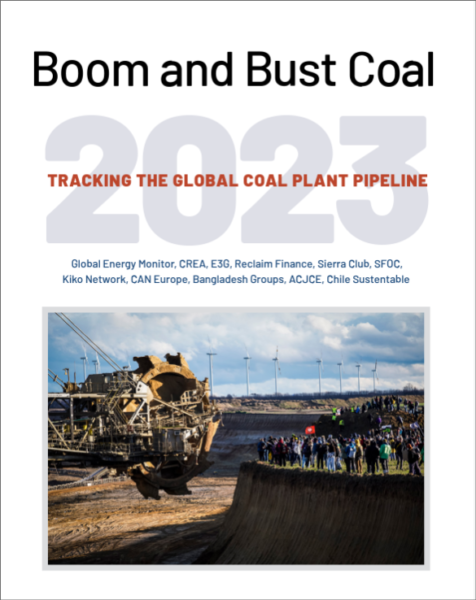Global Energy Monitor and co-authoring organizations have released the report “Boom And Bust Coal 2023”, their 9th annual survey of the global coal plant pipeline.
The report points out that the number of coal-fired power plants have continued to increase even after the signing of the Paris Agreement in 2016, and also notes that Japan is one of the 14 countries that still have plans for new coal-fired power plants as of 2022, moving against the global trend toward a coal phase-out. Although the number of projects under development and construction are becoming fewer, construction and start of commercial operation of new coal units steadily continue in Japan, despite the fact that countries are requested to strengthen the ambition of their 2030 climate targets under the Glasgow Climate Pact, and that OECD countries must phase out coal-fired power plants by 2030 in order to achieve the Paris Agreement goal of limiting global warming to 1.5℃. In addition, the report shows that the Group of Seven major industrial countries (G7) account for 15% (323 GW) of the world’s operating coal capacity.
In 2022, the G7 committed to phase out unabated coal-fired power plants and “predominantly” decarbonise their power sectors by 2035. To ensure the implementation of these commitments, Japan should abandon new coal-fired power plants and quickly move to phase-out coal-fired power plants by 2030.
Key Findings of the Report
- About one third of global coal capacity (580 GW) has a phase-out date, while another 1,400 GW is covered by carbon neutrality targets.
- After the Paris Agreement was signed, the scale of planning new coal-fired power plants around the world has been dramatically reduced. However, the capacity of coal-fired power plants grew by 19.5 GW in 2022.
- Despite global gas shortages and high gas prices, 26 GW of coal-fired power plants was closed in 2022. The U.S. led these coal retirements with 13.5 GW. However, Russia’s invasion of Ukraine prompted a slowdown in coal retirements in Europe, with only 2.2 GW retired. Temporary restarts and extensions of coal-fired power plants are generally expected to wind down in the next few years, and what appeared to be a spike in coal capacity added only 1% to total EU coal generation in 2022.
- While closures continued, China’s planned installed capacity increased by 126 GW, offsetting declines in the rest of the world.
- In order to achieve the 1.5℃ target, an average of 60 GW must come offline in OECD countries each year to meet their 2030 deadline, and for non-OECD countries, 91 GW each year for their 2040 deadline. Accounting for coal plants under construction and in consideration (537 GW) would require even steeper cuts.

We have only seven years left until 2030.
UN Secretary-General Antonio Guterres has urged for the immediate withdrawal of new coal-fired power plant projects and the phase-out of existing coal by 2030 in developed countries, and by 2040 in other countries. Japan must also set a clear date for a coal phase-out and promptly begin implementing it.
Download from here
Boom and Bust Coal 2023 (Link)
Global Energy Monitor, Press Release(English PDF/Japanese PDF)
Written/Published by:
Global Energy Monitor, and co-authors (the Centre for Research on Energy and Clean Air, E3G, Reclaim Finance, Sierra Club, Solutions for Our Climate, Kiko Network, Climate Action Network Europe, Bangladesh Poribesh Andolon, Waterkeepers Bangladesh, Alliance for Climate Justice and Clean Energy, and Chile Sustentable).
Published: April 6, 2023

